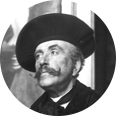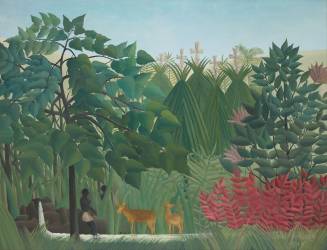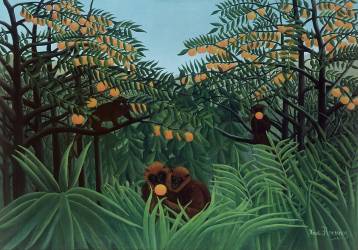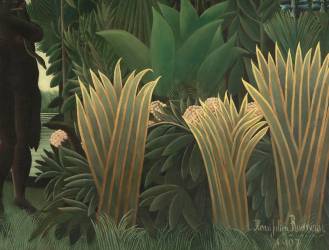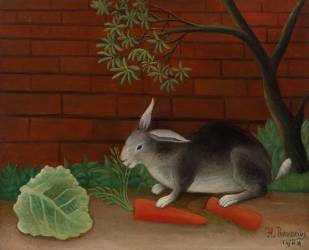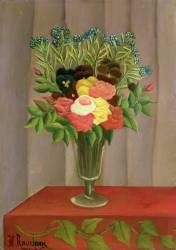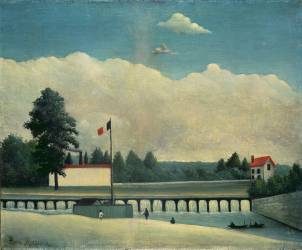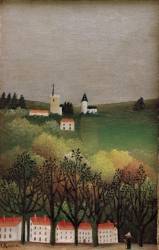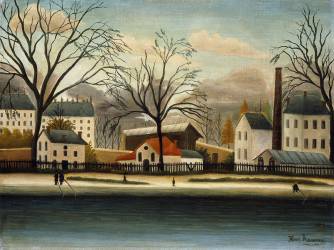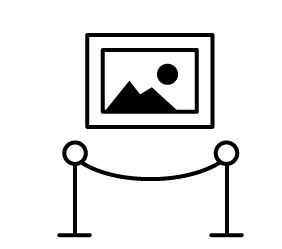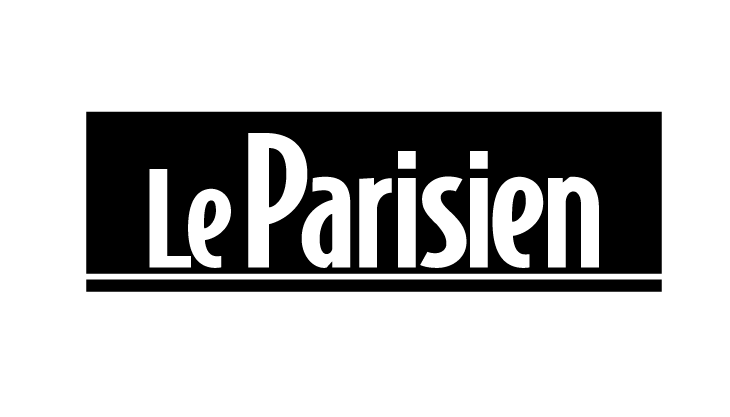Artwork of Henri Rousseau
Henri Rousseau, better known as the Douanier Rousseau, occupies a singular place in the history of the arts. Born in 1844, this self-taught painter, far removed from the academies and artistic movements of his time, forged a unique path, made up of instinct and freedom. His canvases, populated by lush jungles and enigmatic characters, were long considered naïve, even primitive.
And yet, behind this apparent simplicity lies a profound poetry, a singular mastery of colour, opening up a major page in the history of art. Mocked by some, admired by others, it was only belatedly that his talent was recognised by the avant-garde, fascinated by the dreamlike power of his work.
Biography of Henri Rousseau
Henri Rousseau's early years and formative period
Born in Laval in 1844, Henri Rousseau grew up in a modest environment. His father, a tinsmith, instilled in him a certain sense of manual labour and precision, qualities that would later find their way into his painting. Despite his family's lack of interest in the arts, young Henri developed a passion for drawing and music. He attended the lycée in Laval, where he distinguished himself with his drawing skills and even won a drawing prize.
However, life temporarily distanced him from his artistic aspirations. Starting out as a lawyer's clerk in Nantes in 1860, in 1863, in order to avoid juvenile reform school after robbing his employer, he enlisted in the army, this page in his life inspiring future works such as La guerre (1893) or Scène de guerre (1888). It was also during this period that he met soldiers who had taken part in the French intervention in Mexico in 1861, and that the embellished myth of his stay in Mexico was born. Although Rousseau never crossed the Atlantic, this legend would fuel his imagination and influence his distinctive style, blending bright colours with a personal view of the tropical jungle and exotic animals.
Returning to civilian life in 1868, he settled in Paris, married Jeanne Désirée Clémence Boitard in 1869 and, from 1870, worked as a octroi clerk. This job offered him a degree of financial stability and allowed him to devote his spare time to his passion for painting.
The artistic awakening and first exhibitions of Henri Rousseau, known as "Le Douanier Rousseau"
It was in 1871, while working as an employee at the Paris octroi office, a job that earned him the nickname "Douanier" from his friend, the poet Alfred Jarry, that Henri Rousseau began to paint seriously. Self-taught, he trained by copying master paintings at the Louvre Museum, thanks to a copyist's card he obtained in 1884. His works, mainly landscapes and portraits, were initially rejected at the official Salon of 1885, the jury finding them unfinished.
But Rousseau persevered. In 1886, he exhibited for the first time at the Salon des Indépendants, an exhibition space created by artists on the fringes of the traditional circuits. He exhibited four paintings there alongside other avant-garde artists, including the work Un soir de carnaval, but his singular drawing, direct style and original compositions attracted little attention from his contemporaries, with critics using his nickname "Douanier Rousseau" to reduce him to the status of amateur painter.
The framework of the Salon des Indépendants, however, offered Henri Rousseau a platform to exhibit his paintings and gradually build a place for himself in the Parisian art world, away from the official editions and traditional institutions.
The gradual recognition of Henri Rousseau
Despite the lack of success with his first paintings, Henri Rousseau persevered and continued to exhibit faithfully at the Salon des Indépendants from 1887 onwards. It was at this venue, a veritable hotbed of artistic creation in Paris, that in 1891 he exhibited a work that would mark a turning point in his career: Surpris! This painting, depicting a tiger in a luxuriant jungle, attracted attention for its unique style and the detail of its line. While some critics remained perplexed, others, like the painter Félix Vallotton, hailed the primitive force and originality of this painting.
Far from being discouraged by the ups and downs of life, with the death of his wife in 1888, a remarriage in 1899, followed by another widowhood in 1903, Rousseau devoted himself more and more to his art. After retiring from the octroi in 1893, he immersed himself entirely in painting and even gave drawing and painting lessons at the Association philotechnique from 1901.
Progressively, Rousseau's work began to intrigue and fascinate. Avant-garde artists such as André Derain and Henri Matisse recognised the singularity of his style. Little by little, his paintings, often of exotic landscapes, began to go unnoticed. It was at this time that he became friends with young painters such as Robert Delaunay and Pablo Picasso, who even organised a banquet in his honour in 1908. The "Douanier Rousseau", as he was known, was finally beginning to gain the recognition he deserved. His naive style, unique technique and dreamlike world now set him apart in the Parisian artistic landscape.
The apogee and consecration for Henri Rousseau
From 1905 onwards, Henri Rousseau, the self-taught painter, finally saw his work recognised. His painting, Le Lion ayant faim se jette sur l'antilope, exhibited at the 1905 Autumn Salon, attracted attention and aroused passionate reactions.
The year 1907 was marked by an unexpected event: Rousseau was imprisoned for fraud. He then presented an astonishing canvas depicting 21 monkeys perched on coconut palms to defend themselves, once again demonstrating his boundless imagination and unique style. Despite this episode, he continued to exhibit, notably at the Salon d'Automne in 1907 with La Charmeuse de serpents, an exotic and dreamlike work, and at the Salon des Indépendants the same year with Vue de Bretagne.
Merchant Ambroise Vollard took an interest in his work and bought several canvases from him, including Le Rêve, a lush and enigmatic canvas. Thanks to these sales, Rousseau was finally able to acquire his own studio in the 14th arrondissement of Paris in 1909. He was now fully integrated into the avant-garde milieu, alongside artists such as Robert Delaunay, who admired his freedom and sincerity. The influence of Paul Gauguin and Paul Signac can be seen in his paintings, particularly in his use of bright colours and simplified forms.
Rousseau continues to paint with passion, exploring themes that are dear to him: lush jungles, portraits, scenes of Parisian life. His latest works, such as the exotic canvases La Jungle équatoriale and Forêt tropicale avec singes, the still life La Bougie rose or the portrait La Muse inspirant le poète, testify to his growing mastery in a unique and recognisable style, inspiring young artists. Sadly, ill with gangrene, he died in Paris in 1910 at the age of 66, leaving behind a unique artistic legacy that will go down in the pages of art history.
The posterity and artistic legacy of the Douanier Rousseau
In 1947, his remains were transferred to the cemetery in Laval, his home town. On his tombstone, a poem by Apollinaire celebrates his genius. Editions d'art published books devoted to his work, with reproductions of his most famous paintings, such as La Charmeuse de serpents and Le rêve. His exotic, dreamlike style had a lasting influence on the Surrealists and naive artists.
The Musée national d'art moderne, the Musée d'Orsay and many other institutions around the world now have paintings by the Douanier Rousseau in their permanent collections. Major exhibitions, accompanied by catalogues and in-depth studies, are regularly organised. Archives and period documents are studied by art historians, who reinterpret his work and its influence on naive art and the plastic arts in the twentieth century. Many pages are devoted to the Douanier Rousseau in art history books, confirming his place as a major figure in modern painting.
Focus: recurring themes and motifs in the work of Henri Rousseau
The Douanier Rousseau regularly used recurring themes and motifs that gave him a unique identity. His often lush paintings explore the exotic world of jungles with fascination. La Charmeuse de serpents (The Snake Chaser), La Chasse au tigre (The Tiger Hunt) and Combat de tigre et buffle (Tiger and Buffalo Fight) depict an abundance of nature, where dense vegetation provides the backdrop for mysterious wildlife. Rousseau nurtured this taste for otherworldliness without ever travelling, drawing inspiration from the archives of the Jardin des Plantes and the accounts of explorers. The paintings Le rêve (The Dream), Forêt tropicale avec singes (Tropical Forest with Monkeys), La Cascade (The Waterfall) and La Jungle équatoriale (The Equatorial Jungle) perfectly illustrate this lush imagery, peopled with infinite detail, inviting the viewer into total immersion.
Beyond these exotic landscapes, Douanier Rousseau was also interested in depicting his contemporaries. Portrait de Monsieur X, La Muse inspirant le poète and Portrait de femme testify to his ability to capture the essence of a model, with a frontal approach and particular attention to facial features. These portraits, painted with the same meticulousness as his jungles, betray a careful observation of reality that is characteristic of his style. The artist incorporates scenes from everyday life into his paintings. He captures the peaceful atmosphere of his time, in which the realism of everyday life blends with a dreamlike dimension.
The composition of his paintings is often structured and symmetrical, with a sometimes approximate perspective that lends his drawings a singular charm. The use of colour, bright and contrasting, contributes to the unique atmosphere of his works, which are both naïve and sophisticated. Through his paintings, Le Douanier Rousseau offers us a unique vision of the world, where the real and the imaginary come together in colourful harmony.
Learn more about the life and the works of Henri Rousseau.


